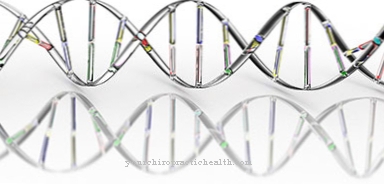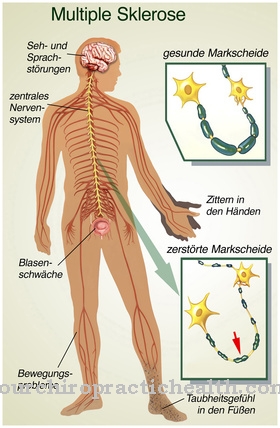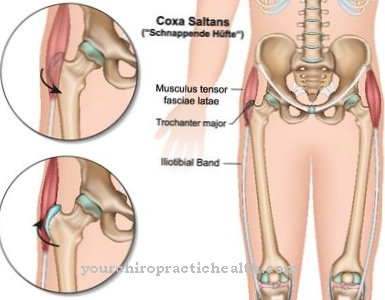Even small wounds can lead to the penetration of bacteria and fungi through the cuticle, nail line or nail wall into the skin of the nail bed and thus a painful one Inflammation of the nail bed (medically too Onychia, paronychia, panaritium called). This infection is one of the most common diseases affecting the fingers.
What is nail bed inflammation?

© Henrie - stock.adobe.com
The tissue on the finger or toe from which the nail grows and is covered by it is called the nail bed. Depending on whether the mostly bacterial infection only affects the nail bed itself or also the so-called perimeter of the nail, a distinction is made between two types of Inflammation of the nail bed:
In the parungual panaritium, the infection affects the posterior or lateral nail wall. This leads to swelling and redness. The subungual panaritium is located under the nail. This leads to suppuration on the nail root or on the free nail wall.
causes
A Nail bed inflammation occurs when certain pathogens, mostly staphylococci, but also fungi and herpes viruses, enter the skin of the nail bed through entry points. Even small cracks that occur during nail care, ingrown nails, cuts and irritation of the skin can serve as the gateway to such an infection.
In the area of the toenails, even shoes that are too tight can lead to an injury. The resulting nail bed inflammation can be acute as well as chronic.
People who are prone to dry skin or atopic eczema (neurodermatitis), people who regularly come into contact with aggressive cleaning agents, who take certain medications, who have diabetes, suffer from circulatory disorders or whose immune system is weakened are also particularly at risk.
However, women are more often affected than men, as pedicures and manicures make them more prone to injuries in the nail area.
Symptoms, ailments & signs
An inflammation of the nail bed manifests itself through a number of clear symptoms. First of all, the inflammation is noticeable through external changes in the nail area: The skin is very red and the tissue swells and hurts. The pain is usually described as throbbing or stabbing. The increased pressure in the affected tissue also leads to overheating of the infected skin areas.
The skin then feels noticeably hot and is very sensitive to touch. The inflamed areas may also be oozing or bluish in color. After a few days, pus will form on the side edges of the nail. These pus patches open up again and again due to the constant strain on the finger, which can result in further infection. Accompanying the inflammation of the nail bed are symptoms such as fever and malaise.
Those affected often notice swelling of the lymph nodes in the elbow and armpit area. Chronic inflammation can cause the nail to peel off. The inflammation can also spread to the surrounding fingers or toes. Then there is painful swelling, which restricts freedom of movement and is associated with severe discomfort. In severe cases, chronic bone inflammation develops.
Diagnosis & course
Characteristic of a Inflammation of the nail bed are both very pressure-sensitive areas as well as redness and swelling, which increasingly cause throbbing pain.
The first sign, however, is a reddening of the skin area adjacent to the nail. As the skin progresses, it swells up and feels overheated. Itching can also occur, especially in the initial phase of the infection. Eventually foci of pus form on the edges of the nail wall or under the nail.
If there is no timely treatment, this inflammation can spread, so that in extreme cases it can penetrate to the tendon sheaths and the bone. Growth disturbances of the nail up to complete rejection are also possible.
The chronic form of nail bed inflammation is often less painful than the acute one, whereby it usually affects several nails at the same time and these can turn bluish or reddish in color at the nail fold.
Depending on the severity of the infection, the attending physician can take a swab of the affected area of skin in order to be able to determine the exact pathogen. If it is presumably a chronic inflammation of the nail bed, the causal diseases or lifestyle must be determined.
Complications
Complications due to inflammation of the nail bed are rarely to be feared. Inflammations that are recognized in good time and treated properly heal in most cases without consequences. Occasionally, minor deformations can remain, but this is only of cosmetic importance. On the other hand, there is a risk of secondary effects if the therapy does not start early.
One of the most common complications of nail bed inflammation is their spread to neighboring body structures. These are mainly the back and sides of the skin that border the nail. As the disease progresses, the inflammation can spread to the point where it affects the entire toe or finger. An inflammation of the nail bed not only spreads sideways, but can also penetrate deeper into the affected toe or finger.
In the worst case, the triggering bacteria work their way to the bone and cause damage to it. The lymph nodes are also considered at risk. These can be reached by the bacteria via the lymphatic system. If the bone is infected, medical treatment must take place immediately, otherwise there is a risk of permanent impairment. The treatment is primarily carried out with antibiotic tablets, which act against the bacterial pathogens.
If the germs spread to other parts of the body, there is a risk of secondary diseases such as arthritis in the joints or bone inflammation. If the bacteria reach the bloodstream, there is a risk of blood poisoning (sepsis), which in extreme cases can be life-threatening. This complication becomes noticeable through attacks of fever.
When should you go to the doctor?
In order to avoid an increase in symptoms and complications, a slight inflammation of the nail bed should be clarified by a doctor. In consultation with the doctor, self-help measures or medical preparations can be used and healing can be promoted. At the latest when home remedies such as baths or creams no longer have any effect, a visit to the doctor is recommended. If the pain gets worse or is accompanied by weeping or purulent areas, the doctor must be informed. The same applies if there is a fever, swelling, or sensory disturbance.
A bluish discoloration suggests advanced onychia that needs to be examined and treated immediately. Anyone suffering from a chronic disease such as diabetes or circulatory disorders should ideally consult the responsible doctor. If you have an inflammation of the nail bed, you can first see your doctor. Depending on the suspicion, the patient must then call in a dermatologist or a surgeon. With early treatment, an onychia will subside after a few days without further complications or long-term effects to be expected.
Treatment & Therapy
As a first step in the event of an upcoming Inflammation of the nail bed, disinfectant solutions or creams can enable rapid healing. Bathing the affected fingers / toes in chamomile tea also often promises to reduce the infection.
If, on the other hand, redness, swelling, pain, possible functional impairments and a feeling of warmth occur, a doctor should be consulted immediately. Therapy for the disease always depends on the pathogen. Different drugs are used depending on whether the inflammation was triggered by yeast, bacteria or viruses and whether another disease is the cause of chronic nail bed inflammation.
If the inflammation has progressed to the point that a fever occurs and the lymph nodes swell, antibiotics can also be prescribed. In the event of a yeast infection, antifungal ointments are also prescribed. Herpes viruses, on the other hand, can be treated well in the form of antivirals that are applied as ointments.
Since an inflammation of the nail bed is associated with pain and impairment of the function of the respective finger / toe, immobilization by means of small splints or elevated positions may often be necessary. If the nail bed inflammation is in an even more advanced stage, surgery can also be considered. Here, the doctor opens the pus focus under anesthesia by either removing the nail entirely or by making an access through it. The pus located there is then drained and the wound is treated with a disinfecting ointment bandage. If a nail had to be removed for opening, it usually grows back within a few months.
If the infection is caused by impaired nail growth, for example due to an ingrown nail, the nail can be reduced in size during an operation. Since misalignments of the foot can lead to injuries and, as a result, to disease of the nail bed, orthopedic insoles can also be prescribed.
In rare cases associated with wound healing disorders and dead tissue, an amputation is ultimately required to prevent the infection from continuing.
Outlook & forecast
The vast majority of acute inflammation of the nail bed is free of complications and heals itself completely within a few days to weeks. In more severe cases, treatment with antibiotics may be necessary. If pus has accumulated under the nail that cannot drain away, a doctor must open the pus focus. Otherwise, the nail may become detached, and in the worst case, even life-threatening blood poisoning.
For a positive course of healing, it is necessary to eliminate the causes of the inflammation. Very often these are mistakes in nail care that lead to small injuries through which bacteria penetrate the nail bed. The greatest risk factor is the removal of the protective cuticle, but ingrown nails can also cause nail bed inflammation. In addition, contact with caustic cleaning substances is a possible cause. Appropriate protective measures must be taken here. If severe pain occurs, a doctor should be consulted.
The prognosis is less favorable for chronically ill people who suffer from neurodermatitis or diabetes because their immune system is weakened anyway. The dry skin creates cracks that can catch fire. Severe courses, in which the inflammation can spread to the surrounding tendons or even the bones, are rather rare and usually only observed in immunocompromised people.
prevention
As a preventive measure, it is important to ensure that fingernails and toenails are cut regularly to prevent them from growing in or breaking off. When filing, you should never go too deep into the side wall. Cuticles should also not be removed with scissors, but with a rounded pusher.
Regular hand and foot baths as well as oils and creams keep the skin supple and counteract cracked, dry skin. Gloves should always be used when working in the garden or with chemicals. In the area of the feet, care should be taken to wear a well-fitting shoe that does not create a feeling of pressure. In addition, special gymnastic exercises can stimulate blood circulation.
Aftercare
The nail bed inflammation can experience sustainable regeneration through consistent follow-up care. Even a relapse can often be prevented by targeted follow-up care. In this context, it is ideal if the cause of the nail bed inflammation is known.
If the cause is excessive nail care, aftercare and prevention are at the same time to turn these habits off. Sharp cleaning products and excessive shortening of the nails or cutting of the cuticle should be avoided as part of the aftercare. Nail polish and nail polish remover also have irritative potential, which is why patients should avoid them. Torn nails can be treated both gently and professionally in foot care.
If chemical exposure, for example in the workplace, is responsible for the nail bed inflammation, this is also an important topic in follow-up care. For example, wearing gloves is a measure that can prevent inflammation under certain circumstances. This also applies to gardening, where soil in the area of the nail bed can also trigger inflammation or prevent inflammation from healing.
If inflammation occurs frequently, this may also be due to an immune deficiency or diabetes. After clarification by the family doctor, it often makes sense in the follow-up care to effectively and long-term strengthen the defenses of the person concerned through a healthy diet, enough sleep and sufficient amounts of water.
You can do that yourself
Measures to combat inflammation of the nail bed can be carried out not only with medication but also with self-help. So that the painful bacterial inflammation on fingernails or toenails can affect everyday life less, it should first be hygienically bandaged and thus protected. On the one hand, this reduces the pain sensitivity to touch or impact. On the other hand, it can also prevent further soiling. Small injuries that allowed bacteria to penetrate could otherwise continue to be a weak point.
If it is an inflammation of the nail bed of a toe, shoes that are too tight should not be worn. The purulent inflammation can be treated in a number of ways. It is helpful to brush with clove oil or garlic stock. A compress with arnica is also useful. The affected foot or hand should also be bathed in warm water several times a day. This softens the horny layer and enables better pus drainage. Bath additives such as chamomile and salt also have an anti-inflammatory effect.
The nail affected by nail bed inflammation can also be bathed in a lukewarm tea made from marigold blossoms and rosemary. Dissolving two tablespoons of curd soap flakes per liter of water is an old, tried-and-tested home remedy for an inflamed bed of nails. Likewise, the nightly action of compresses with healing earth. The suppuration process can be promoted by Silicea (silica) in the case of nail bed inflammation.


.jpg)





















.jpg)



